MEANDER #10 Friday 14 July 2017 On July 1, Canadians celebrated 150 years of nationhood.
Eight days later, my extended family, as it has traditionally done, celebrated July birthdays. The birthday party took place on the farm where I and my five siblings grew up. We passed on shooting off fireworks for the birthdays, even not lighting candles. Instead, we majored in visiting, watching the youngsters play and playing some games with them, dug into a delicious meal, and for a few of us adults chugged off down memory lane in a tractor parade.
On the morning of the birthday party (Sunday, July 9), nine of my siblings and spouses gathered for “church” at the home of Brian and Vivian Bender in New Hamburg. Their regular church was conducting the service at Nithview, a retirement living and nursing home. I shared a message, “How far to the bridge?”, that I had given on July 3, 2005, at my church in Indiana. The topic was how a Christian maintains citizenship in two kingdoms. The term, “Christian citizenship,” I said, implies “a citizenship that includes living fully as citizens of God’s Kingdom that incorporates all of creation and our hope for the future, and living fully as citizens of one of the world’s nations.”
Before my somewhat condensed presentation I did a one-sentence children’s time (for the benefit of the child in all of us, of course). The words, from a booklet, Who Cares?, edited and complied by Mary Oakley, are those of a 9-year-old boy: “God and me are good friends–most of the time.” We nodded and chuckled in agreement.

The morning ended with a fine lunch of scones, Devon clotted cream and jam and other goodies. The birthday party for the extended family took place in late afternoon.
On Monday, July 10, a group of 12 did a tour to explore a patch of Huron Road history, from the recent past to the time settlers arrived before confederation. Organizer Ray Schlegel, and others, arranged what we termed the Historic Huron Road Highlights Tour, a section from Haysville to Shakespeare. More follows in pictures and text.
The July birthday party
Along the Historic Huron Road
The Huron Road played a significant role in the development of southwestern Ontario. Tour participants had some personal connection or interest in the history and culture of the Huron Road, especially the Haysville, St. James Anglican Church, St. James School, Punkeydoodles Corners, and Fryfogle’s Inn/Shakespeare section.
Carol Massel welcomed us to the historic St, James Anglican Church, the mother church of a three-point parish. It opened in 1854 and saw a succession of developments as well as demographic changes that led to its disuse as a weekly worship center in 1931. It is now used as a funeral chapel and two annual services: Anniversary Service, 2nd Sunday in June, and Thanksgiving Service, Sunday, a week before Thanksgiving. St. George’s Anglican Church in New Hamburg is now the place of weekly worship and service.
“When the first European settlers arrived in Wilmot Township in the 1820s, most of them were of German origin. . . . While the Germans and Amish occupied the northern and central parts of the township, English immigrants arriving in the 1830s gravitated to the southern part of the township. They settled along the Huron Road, a stagecoach road running through the wilderness from Hamilton to Goderich. This was the main colonization route leading to the Canada Land Company’s extensive land holdings covering present-day Perth and Huron Counties.” (from a booklet, 175 Years of Anglican Worship in Wilmot Township: A Journey of Christian Faith and Action, 1838-2013, published October 19, 2013).
Carol noted that Anglican worship in 1838 was held in homes in the then thriving community of Haysville and from 1842 in a schoolhouse on the Huron Road. In 1854, the nave of St. James Church was built. Early Anglican families included the Kerrs, Marks, Puddicombes, Smiths, Tyes, Walkers, and Woods. With the coming of the railroad through New Hamburg, the population and commerce shifted there as well.
Barbara Kerr Dobson, who grew up on a nearby farm recalled the paisley shawl her grandmother used to wrap up the children to take them to church on Sunday. She added, wistfully, “Does anybody go to church anymore?’
Almost coincidentally, organist Keith Thompson was on hand to play hymns on the pump organ originally installed in 1888. The organ was restored in 2013. Carol also invited us to ring the bell, a 3000 pound bronze bell installed in 1896. The church has beautiful original stained-glass windows and an attractive and inviting interior.
I have admired the church’s architecture ever since growing up in the area and this was the first time to see inside. As a Chapel of Ease & Cemetery, St. James is truly a place of spiritual heritage and promise and witness to God’s holy presence in the community today.
Lunch on the lawn at the farm
The Huron Road tour group stopped for lunch at the farm of Chuck and Cathy Bender. Chuck and Cathy’s children are the fifth generation on the far. Chuck’s parents, Cleo and Joan Bender, were part of the tour, along with Carol Massel, Barbara Kerr Dobson, Ray and Marianne Schlegel, Ralph and Marjorie Bender, Brian and Vivian Bender, and John and Marty Bender.
Lunch on the farm was like a God-send. We were nourished in body, mind and spirit.
Last stop of the day, Fryfogle’s Inn
Our final stop after lunch was at Fryfogle’s Inn, close to the village of Shakespeare. Happily, extensive efforts are underway to restore the Inn, another key marker of the roads that led to Canadian federation in the really recent past of 1867.
Too little time to sum it all up
Sadly, time ran out to complete all the stories and reflections of the day. Our agenda was focused on a short section of the Huron Road. Another time we would include a remembrance of our underlying Aboriginal heritage, a story that goes back 10,000 years. We would also look at the arrival of the first European settlers 1,000 years ago at L’Anse Aux Meadow in Newfoundland. Ruins of Leaf Erikson’s Icelandic community were discovered there in 1960 by Norwegian archeologists.
Looking back can enrich our historical perspective by leaps and bounds. Going forward, Canadians would do well to fine-tune history by officially recognizing that Indigenous Peoples are one of the country’s founding peoples along with the French and the British, as a writer noted in a letter in the Toronto Star (July 11). Looking back to look forward we encounter a wider glimpse of who we are and why we are.
A fair appraisal of the past, then, includes coming to terms with the tragic and messy stuff, as well as celebrating the good stuff. Marilynne Robinson in Gilead captures the underside of what history holds: “History can make a stone weep” (Farrar, Straus and Giroux, New York, 2004). Thankfully, looking back lets us see wrongs of the past and helps set a sounder agenda for today. We are served well when we set our sights on learning from the past, valuing the present, and working for a better future.
In my 2005 message I left the congregation with a number of suggestions for reflection. I’ll note two of those. To the eldest I said, “As you have reached and exceed three score and ten, you’ve experienced something like crossing the equator. Crossing to the other side of 70 has great significance. As you sailed across the time equator, you didn’t suddenly move from middle age to ‘old’. You are simply now in the greater freedom years that can be a happy time for you. Share your experiences and wisdom. How close are the riches of God’s Kingdom to you in your daily life? What is helping you to live fully in this world and even more fully in God’s reality? What things really matter? How are you exercising your Christian citizenship to benefit your extended family, you community, the world, yourself? What is your hope? Your joy?”
To children I said, “The future holds great promise. The rest of us want to work to leave this world a better place. We have much work to do. We want to leave this faith family a better one for all of us to grow as the body of Christ. God loves you, cares for you, and when you are ready, will accept you as a full citizen of the church. Joy, laughter, life-long learning, and God’s protection, peace and blessing be with you.”
Even unfinished stories can be satisfying. The fact that many such stories arose in the past week gives me so much to munch on. And to digest.
Photo from Vivian’s garden

Featured image
At Brian and Vivian’s home: The early morning dew shows off the spider’s many intersecting roads to a meal. Fly, drive, walk carefully. Just don’t stand still. Cross the bridge. Be happy for history. Celebrate birthdays. Encourage kids. Make new friends. Stop writing and get a second cup of coffee. Cheers!
Yours,
-John
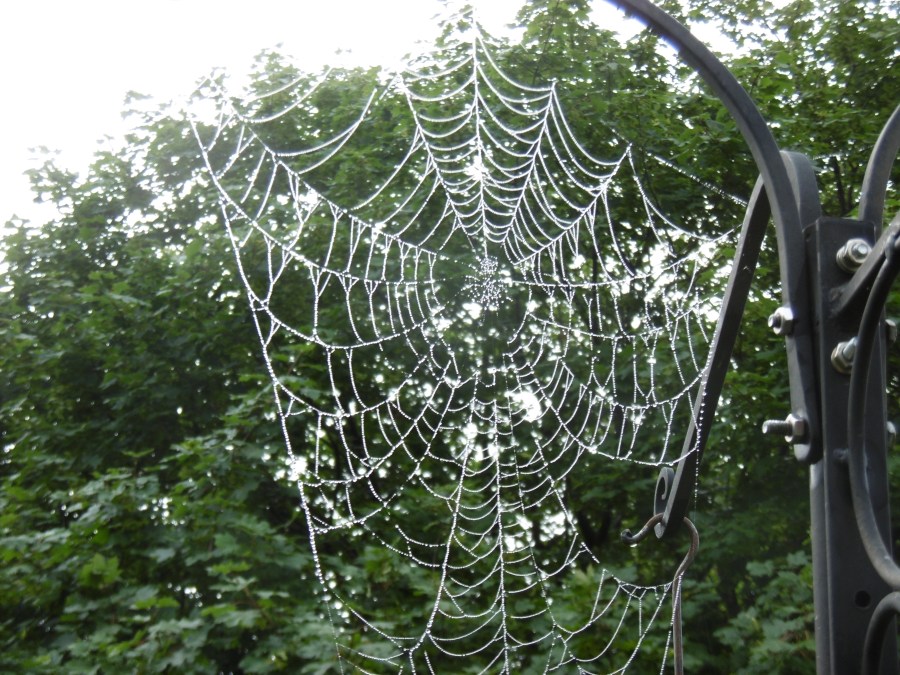
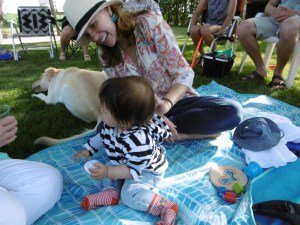

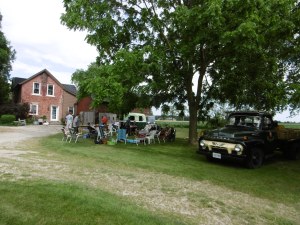
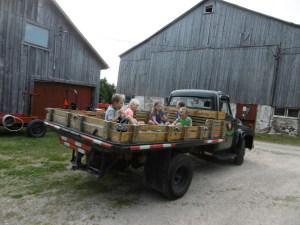

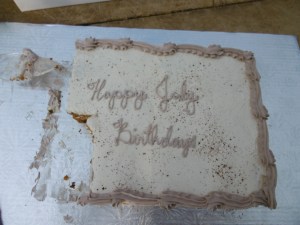
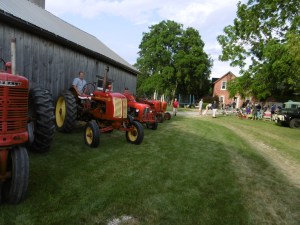


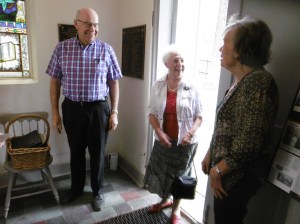


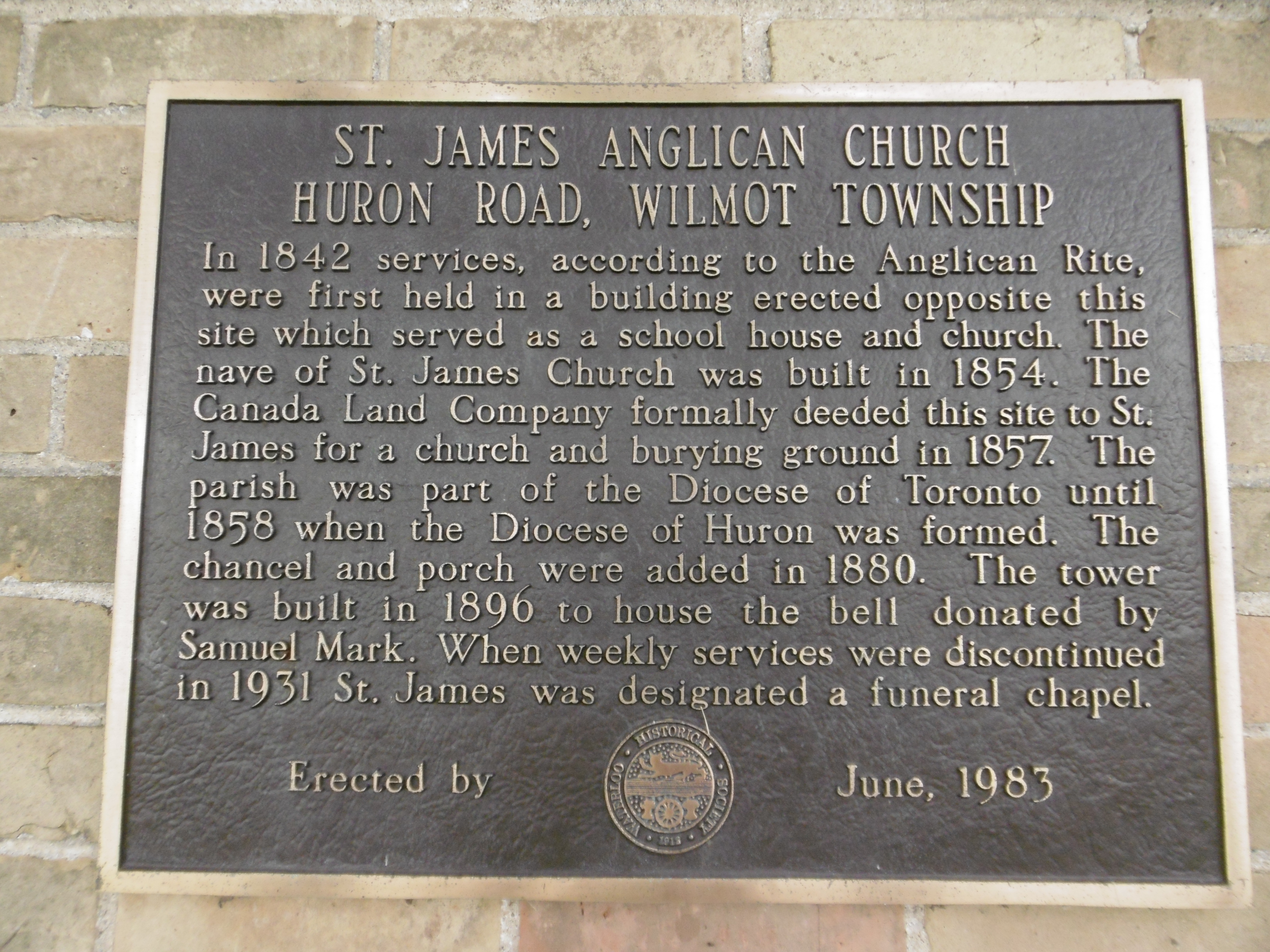
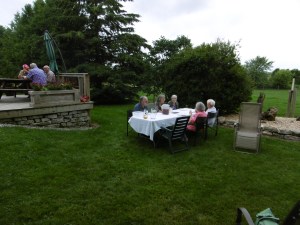

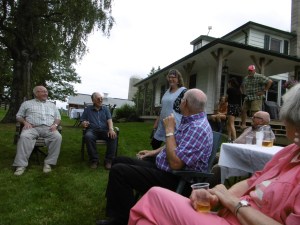


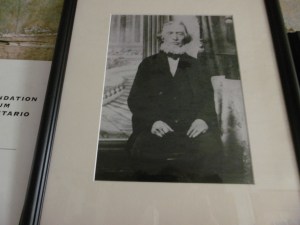

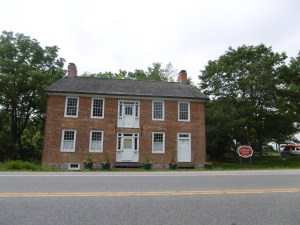

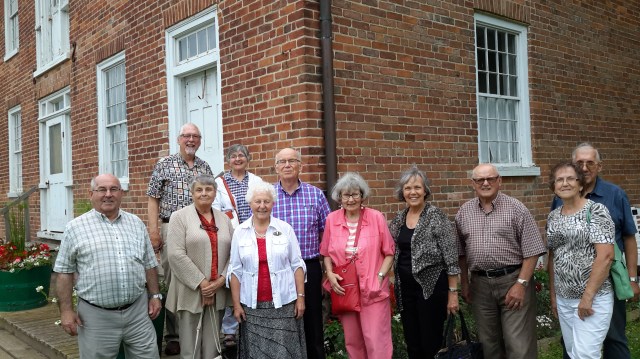
What a fabulous week, John! Your reflections on the big picture of history, your beloved family history and relationships, and the tiny, almost hidden details you observed offered moments of great pleasure in reading.
Marlene
LikeLike
What a nice recap of your visit to Ontario which I was part of. The tractor parade was a nice addition and surprise to our celebration. I have a big smile when I watch the video clip. I enjoyed seeing the Huron County tour through your pictures and words. Grew up here but never really knew any of this. Informative!
Kaye
LikeLike
Thank you for sharing your very interesting tour along with pictures and the history. Very informative.
LikeLike
Good to hear from you, Luanna. You would have many stories to add to the Huron Road saga, especially from the St. James School. Let’s do coffee with you and John at Balzac’s next time we’re in Stratford. Best! -John
LikeLike
Thank you John, for sharing your photos and story of your visit to Ontario. I know Ralph and Marjorie really enjoyed the tour you had on Monday! I have fond memories of spending time at your parents farm, and often remember that I watched my first tv show in their kitchen. I think Sandford bought it and so wished we could have a tv. We had a wonderful visit with Mark last Sunday as well.
LikeLike
Thanks, Ruth. The past serves up fine recollections, smiles, laughter, tastes and once new experiences. Christmas times together at our various parental homes were the real thing, joyous times of food, playing with gifts, and, of course, indulging in homemade candies. Best! -John
LikeLike
John you probably don’t remember me Carol (Bender) Roth. My parents were Willis & Dorothy Bender. I also remember being invited to Sunday dinner at Lloyd and Leona’s! I very much enjoyed your informative blog which Marlene shared with me. It must have been an awesome walk down memory lane!
LikeLike
How nice, Carol, to hear from you. I do so well remember your parents. About this time many, many years ago your dad joined us at the farm to stook wheat. He also operated the binder. Good memories! Enjoy the summer! -John
LikeLike